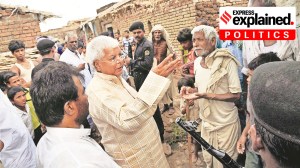Bharat Bonanza
HE formal launch of the Bharat Nirman Programme is due this week, to coincide with Jawaharlal Nehru’s birth anniversary on November 14....

HE formal launch of the Bharat Nirman Programme is due this week, to coincide with Jawaharlal Nehru’s birth anniversary on November 14. Prime Minister Manmohan Singh is expected to write to all chief ministers, inaugurate appropriate websites and release booklets.
But what exactly is Bharat Nirman? Beyond being spoken of as the great hope for rural infrastructure, what are its specifics?
Much like the previous BJP-led NDA government’s National Highway Development Programme (NHDP), Bharat Nirman is the Congress-led UPA government’s showpiece. It is its idea of a flagship development programme that will, through a series of multiplier effects, fight poverty, spread economic prosperity and, in general, make a difference to the lives of ordinary Indians.
The roots of Bharat Nirman lie in the NHDP, especially the Golden Quadrilateral — a buzzphrase in the NDA years. The Manmohan government realised it had to do one better. So it added to the Rs 30,000 crore the Atal Behari Vajpayee government had set aside for NHDP phase I, pushing up the total outlay to a whopping Rs 172,000 crore over a seven-phase period.
Next it added its ‘‘aam aadmi’’ twist, by promising grassroots development — rural versus urban, really — through the Bharat Nirman Programme.
The search for a political legacy
SO far, so good. But what is new in the Bharat Nirman project? As it happens, nothing. A close look at the programme shows it is all about setting targets for existing schemes and clubbing them together, under the watch of the Prime Minister’s Office.
Bharat Nirman’s focus is six categories of rural infrastructure — roads, telecom connectivity, housing, drinking water, electrification and irrigation. Over the next four years, ending 2009, the programme envisages that the Centre and state governments will meet set targets in these areas.
Prime Minister Singh is said to be personally keen on fulfilling Bharat Nirman. People familiar with sarkari jargon would notice that, probably for the first time, the government has used expressions such as ‘‘business plan’’.
In October, at the Congress Chief Ministers’ Conclave, Singh made his point clear:‘‘Our government has conceived a time-bound business plan under Bharat Nirman … the flagship programme for our government.’’
The target for 2009 is: ‘‘To ensure that every habitation has potable drinking water. Every village of over 1,000 population, or over 500 in hilly and tribal areas, must have an asphalted road. Every village must have electricity and telephone connectivity. We must ensure that over one crore hectares of land is irrigated. We have to ensure that at least 60 lakh rural houses are built … Bharat Nirman will be our legacy.’’
Manmohan has spoken of Bharat Nirman as his government’s ‘flagship’ programme, one that will be personally monitored by him. If he can ensure his ministries deliver, the Congress has a sure vote winner. If not … |
Singh also promised the programme would be up for public audit through websites. This week, his government will formally upload six websites. By clicking on these it will be possible to monitor the six component areas of Bharat Nirman, state-wise.
Crunching the numbers
WHAT are the sectoral targets under Bharat Nirman? To date, the prime minister has had two meetings with officials from the Planning Commission, Finance Ministry and other concerned ministries purely to discuss the nitty-gritty and the numbers.
While sources of financing have yet to be firmed up, individual ministries have been given tentative, four-year targets.
• Under irrigation, the target is to bring 10 million hectares under assured irrigation — 4.2 million hectares under major and medium irrigation projects; 3.8 million hectares under minor, groundwater irrigation projects; and one or two million hectares through improvement of tanks.
• Under drinking water, the hope is to provide drinking water to the remaining 55,067 uncovered habitations and 308,995 slipped-back habitations. An estimated 216,968 homes provided only poor-quality water and 230,968 rural schools deprived of drinking water are also on the help list.
• Under rural roads, the target is to connect with a road 37,739 villages that have a population of 1,000 or more, and 21,629 villages in hilly/tribal areas that have a population between 500-999.
• Under housing, the aim is to construct six million additional houses for the poor.
• Under electrification, the target is to reach 125,000 villages — 80 per cent through conventional grid connectivity, the rest using non-conventional energy sources — and switch on the lights in 23 million households.
• Under telephony, the plan is to provide telephone links to 66,822 villages.
The total spending on these components is expected to be Rs 174,000 crore.
Over four years, Finance Minister Chidambaram has to find an extra Rs 71,000 crore for the fresh obligations that Bharat Nirman will entail. For the final four months of 2005-06, he’s found Rs 6,000 crore. The calculations will begin in earnest next year |
And where’s the money?
TARGETS are one side of the story, funding for Bharat Nirman is the other. The Rs 174,000 outlay has two components: the regular budget — ‘‘business as usual’’ expenditure, as one bureaucrat puts it — for the various projects, and the additional expenditure in meeting specific targets under the programme.
According to information collected from various ministries, under the ‘‘business as usual’’ head, the government would anyway have spent Rs 102,700 crore over the next four years. The specific targets have added another Rs 71,300 crore. Looked at differently, the government now has to garner about Rs 18,000 crore of additional funding every year to meet its Bharat Nirman targets.
At the first Bharat Nirman Programme meeting in June 2005, the finance minister promised that, for fiscal 2005-06, he would be able to provide Rs 6,000 crore. With four and a half months left for the financial year to end, the Rs 6,000 crore should be enough. The problem will begin next year.
Counting the pennies
ETERNAL optimists, Finance Ministry bureuacrats say, starting 2006-07, they will raise the additional resources through a combination of a ‘‘separate window’’ for Bharat Nirman under NABARD schemes, domestic budgetary support, external assistance, market borrowings and beneficiary contribution.
Take external assistance. During the August visit of World Bank president Paul Wolfowitz, the Bank committed $ 1 billion of its annual lending to India specifically for Bharat Nirman.
Actually, money should not be as much of an issue as it seems to be. For rural telephony, the USO — ‘‘universal service obligation’’, the contribution of private telecom companies towards non-remunerative, rural markets — already has a corpus of Rs 3,000 crore.
Turn to irrigation — which should take up 40 per cent of the entire Bharat Nirman outlay. Irrigation’s additional requirement, however, works to just Rs 16,000 crore over four years. Funds to the tune of Rs 52,600 crore have already been identified.
Spend it, but spend it well
THE key to Bharat Nirman will lie in how efficiently the money is spent. The targets — rather, the success in meeting them — will be the touchstone as it were for India’s most ambitiious rural upgrade initiative.
Already, the confusion has set in, beginning with rural housing. While the Finance Ministry says, as per the budget speech, there will be funding available for six million houses, the contentious word ‘‘additional’’ has caused a mini-war. The Rural Development Ministry maintains the six million houses promised under Bharat Nirman are ‘‘over and above what was announced in the budget’’, thus doubling the figure.
These may appear minor crinkles in the broader fabric. Four years from now, in the summer of 2009, the UPA will seek re-election and the success or failure of Bharat Nirman will decide its fate. It will be Manmohan’s turn to talk of (Rural) India Shining.
How will history repeat itself?
PWD: Public works in danger
Without NHDP-type institutional innovations, Bharat Nirman could be more money down village drains, warns Ila Patnaik
Since private money is not forthcoming for infrastructure projects in rural areas, there is no option but for the government to spend. But will the Bharat Nirman project be able to improve rural India’s bijli, pani and sadak?
The UPA is hoping to replicate the success of the NDA’s flagship scheme of building national highways. The first question to ask is would the NHDP (National Highway Development Programme) have happened if the NHAI (National Highway Authority of India) had not been created solely and exclusively to implement the NHDP?
Maybe. But it would, most probably, have taken much longer, been costlier in the process, and the end-product might have been inferior.
In contrast to the NHDP, the implementation of Bharat Nirman will be spread across hundreds of government departments all over the country. The track record of state public works departments suggests that there is reason to worry. Projects could get delayed, the quality could be substandard, and yet, no one will be held accountable.
| In contrast to the NHDP, Bharat Nirman’s implementation will be spread across hundreds of government departments. There will no exclusive agency focusing on just this programme |
MOREOVER, the NHAI was not only a dedicated arm of the government, created to complete a defined activity in a defined period of time, it also devised new mechanisms and designs for implementation of the programme.
Road design documents for each stretch of 100 to 200 km were created with the help of international consultants to help ensure quality, as well as prevent political interference. At later stages of the work, monitoring was done not just by NHAI staff, but also by these consultants.
The result that is being seen is not merely the consequence of spending big money on roads. It is the result of the institutional innovations that were made.
Second, is it not enough to build roads without creating the institutional framework that will ensure that the roads will be maintained. Government departments have constructed roads for 50 years. The poor maintenance of these roads is in sharp contrast to the maintenance of the NHDP roads.
THE question of institutional changes arises equally for the other programmes being proposed. If spending money to lay pipes was the answer to India’s woes of inadequate drinking water, India would have had at least good urban drinking water supply.
However, this is not the case. The problem is not the money, but the institutional framework that offers no incentives for maintaining the pipes, ensuring that the pipes don’t leak, and that it does not mix with sewage.
Rural India does not have the economies of scale required to run drinking water plants in each village. Moreover, it does not have the technical expertise and engineering capacity locally available to maintain such systems even if they are put in place.
What is needed is not more money for laying pipes. It has been done for decades, and yet, in most of the country, for most of the time, most pipes run dry. What are needed, instead, are systems that work.
So, for example, in the case of water, it has been proposed that the government should first focus on creating a well functioning urban drinking water system, where there are both economies of scale and the technical expertise. Once this is done, the water board of each town should be made in charge of the drinking water supply to the surrounding rural areas.
This could be one solution, there could be many others, differing from district to district. We do not know what will work. But we do know what does not work.



- 01
- 02
- 03
- 04
- 05




























